Purchasing machinery can be a massive undertaking — especially if you are in the market for used 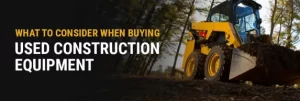 construction equipment. Used equipment is a cost-effective option, but you need functional equipment for your project. Used construction equipment is often considered to have more risks and unknowns than new machinery purchases do. To reduce these risks and find a fair deal, consider these tips for buying used heavy equipment. There are several factors to consider when buying used equipment that will help you make the right decision without wasting your time and costing you unnecessary amounts of money.
construction equipment. Used equipment is a cost-effective option, but you need functional equipment for your project. Used construction equipment is often considered to have more risks and unknowns than new machinery purchases do. To reduce these risks and find a fair deal, consider these tips for buying used heavy equipment. There are several factors to consider when buying used equipment that will help you make the right decision without wasting your time and costing you unnecessary amounts of money.
The first factor you want to check is the seller’s information and reputation. Inspecting the individual or company who is advertising the piece of equipment is essential because this could give you insight into the nature of the transaction. If they are a reliable seller and have testimonials or an established presence in the industry, it will be easier for you to trust their specs on the machinery.
If the seller is difficult to find, put a little effort into learning their identity. See if you can locate information from past customers or how long they have been selling used machinery. The integrity of the seller will give you more confidence in making the purchase.
Buyer and seller history will inform you on how to buy used heavy equipment. The machinery’s past changes in ownership will partially show you the frequency of use and the amount of time it has been circulating. Also, the reputation of previous owners may show you how well the equipment was maintained.
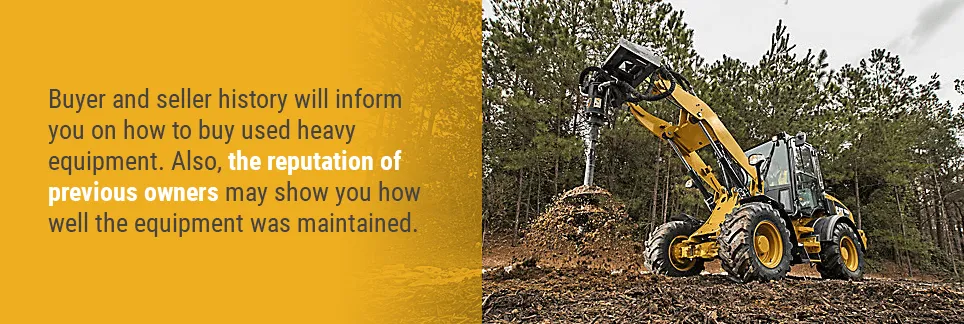
While you are researching the machinery’s past ownership, also check with the authorities to ensure that the machinery is not stolen. Take the product identification number and serial number to the police department to avoid purchasing stolen equipment. Certain online services can check whether or not your equipment has been involved in theft or damages. The National Equipment Register is one entity that performs these checks.
If the equipment has liens associated with it or has been seized, then ownership of the equipment may be more complicated than you want. Do a lien search because an issued statement from the owner considering liens will not give you maximum legal protection. Check if equipment has liens against it by finding the financing statement from the Uniform Commercial Code. This information is posted so you and other used construction machinery buyers can confirm lien information. There may be a history of liens against the equipment, but this will notify you on existing liens in particular.
If a piece of equipment has been seized, be wary of its condition and if it has received proper maintenance. Because seized items have been removed from buyers who could not pay in full, the likelihood that the equipment has not had regular upkeep while being held is high. However, this is not always the case.
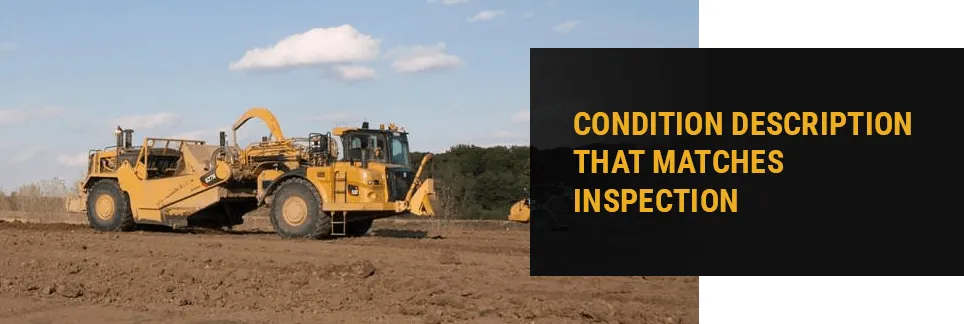
If you inspect the equipment or have an expert inspect it and find that there are discrepancies in the seller’s description, avoid this purchase. Especially if the discrepancies are significant features or issues, you should not purchase the machinery. Any signs of dishonesty or lack of thoroughness can put you on the losing end of a deal.
If you are familiar with how excavators or other machinery look in the different stages of their lifespan, then you can inspect the equipment yourself. Inspect the parts of the equipment that are replaced most often to judge if the equipment has received new parts recently or will need immediate replacements. Despite minimal wear and details that may be too minor to mention, the seller’s description should come out as accurate in comparison to your inspection.
However, if you are not confident in your ability to inspect, bring an expert or a trusted colleague who will be able to assess the state of the machinery. With used equipment, you may be willing to accept its condition if the price and length of your project match up. Examine places that receive the most abrasion during use, like the undercarriage. If the seller’s description and you or your expert’s assessment do not agree, you must make the call on whether this purchase is still worth making.
Judging an appropriate listing price when buying and selling used construction equipment includes many considerations. The listing price should not be at the same level as a new piece of equipment, but it should represent the worth of a machine based on its operating time, age and past maintenance. On the other hand, the listing price should not be dangerously low, because this is suspicious, too. The seller that you are purchasing from must sell the equipment in a limited time span to get the best value, so consider the depreciation and salvage value.
Salvage value and depreciation are two critical factors in calculating the potential cost of used equipment. For instance, most used equipment only retains about 50 percent of the value of the machine when it was placed on the market after the first fourth of its lifespan. As time goes on, the value of a machine declines, although many still consider well-maintained machinery to be advantageous despite the age.
Maintenance factors to be considered in purchasing used equipment are the frequency of care, major repairs and current replacement needs. The records of damages will give you insight into the kind of work the machinery has been used for in the past and if it has sustained too much heavy construction work to continue being useful. If more serious or reoccurring damages have happened to the equipment, then this may steer you away from the purchase.
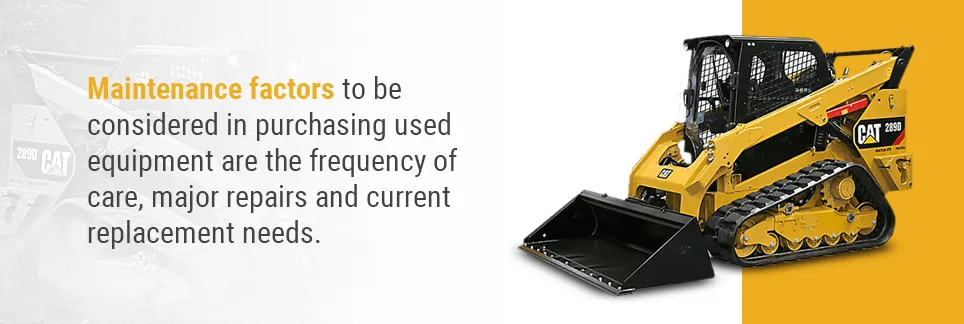
If a backhoe loader has regularly needed repairs for the loader arms and continues to have cracked paint and metal in that area, you will want to know this for your projects. Before purchasing this machinery, you can factor in the downtime you may need to restore the equipment by checking past maintenance details. Knowing what to expect for a piece of equipment can also increase safety when you and your associates use the machinery.
If machinery has a regular record of careful maintenance, then you should experience fewer operational problems. Cleaning, inspections and greasing are all essential maintenance practices for many kinds of construction equipment. Did the previous owner or owners consistently perform these duties? A well-maintained machine will continue to complete efficient work for your needs.
The amount of time that machinery was used is a significant factor in its further usefulness. Age and maintenance both affect how substantial operating hours are for equipment. Owning a piece of equipment for a long time and minimally using it will be more expensive, so you may come across an owner who no longer wishes to go on with their current expenses. However, little use and pristine maintenance practices can be beneficial for the buyer.
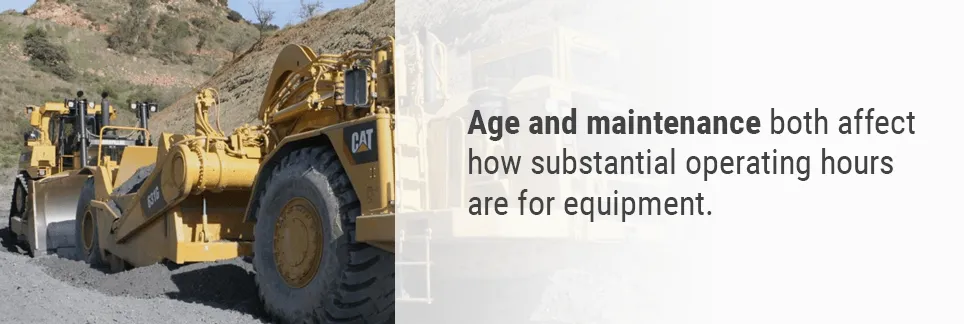
Machinery used full time will wear down more quickly and require replacement parts more often than part-time use. The former owner should be able to estimate the average amount it was used per week, which should give you insight into the continued lifespan of the equipment. Although age constitutes such a large portion of the value of a machine, annual use is a critical factor in the worth of construction equipment.
Among the tips for buying used construction equipment, spotting signs of poor maintenance will protect you from bad investments more than most others.
Expect wear and tear on used construction equipment, but do not ignore signs that will lead to major problems and delays for your projects. Loose pins and questionable bushings are some indications that the previous owner neglected maintenance. These may break in the future and cost you time and money to tend to. There are material considerations in bushings that may make replacement more difficult. Tend to these loosened parts quickly, because they can become worn sooner than you expect.
Check the brakes on the machinery and the tires to ensure that they meet your expectations. Essential parts of the equipment like these should be functional and not worrisome if you are about to make this investment. If tires on a used skid steer loader are not in good condition, you can replace them, but this will be at your own cost. The seller may rate them good or fair, but size up the pros and cons before purchasing a used skid steer loader.
If rust or cracks are present, this could be evidence of poor maintenance. Cracks on the exterior that may seem harmless could be a precursor to infrastructural cracks in the machinery, so compare the maintenance records with these signs to weigh the possibility of serious damage.
The various fluids of the equipment can also reflect the upkeep or warn of future difficulties. As you are inspecting the equipment for other signs of maintenance, check each fluid level to get a more well-rounded understanding of the machinery’s shape.
Low fluid levels show a lack of continual management. If the hydraulic fluid or transmission fluid have not been maintained, the machine may not run smoothly or transfer heat effectively. Depending on how old the machines are or how much they have been run, certain maintenance needs may not be necessary yet.
Dirty fluid also is a sign of danger for the equipment. Most essential fluids will simply turn a dark brown color if they are contaminated. Other fluids look cloudy or have a particular smell when they need to be renewed or changed out. Ensure that brake fluid is not contaminated with water or similar harmful substances.
If fluids are leaking and leaving small pools of residue underneath the equipment, this is evidence of a larger complication. This could also explain why liquids may be extremely low. Do not only check underneath the machinery, but also look over the cylinders. Leaking coolant or lubricant shows that this used machine may need extreme maintenance.
Any signs of mixed fluids show underlying issues, too. If coolant and oil are mixed together in either fluid chamber, an internal breach has most likely opened. Engine damage has potentially already happened due to this, or it will soon follow. Invest in machinery that is free from fluid mixture, leakage, reduced levels and contamination.
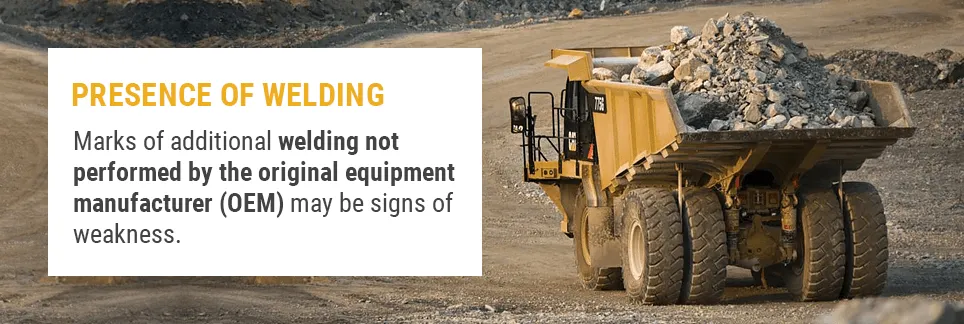
Marks of additional welding not performed by the original equipment manufacturer (OEM) may be signs of weakness. Welding is typically substandard to the machinery’s initial material. Adding to the metalwork done in the manufacturing facility is not beneficial. Machines without welded repairs and evidence of breakage are better options than those that do have this.
Check common places where cracks occur, like in the loader arms or buckets of construction equipment. If there are minimal welding spots, then you may still choose to purchase the used machinery. However, if the amount of welding is extensive, opt for a different piece of equipment that will be more durable and last longer than welded machines.
Mechanized or automated welding is superior to manual welding, and any welding done to the machine parts post-manufacturing would be manual. The few deviations that do occur in automated welding have a correction process that significantly increases their durability. Considerable welding is a reflection of extreme use, as well, which means you would not get as much work out of your used equipment.
Having a chance to test drive the equipment will allow you to check the engine’s sound and the standard capabilities of the machinery. If your seller is willing to let you run and examine the equipment, it is probably a genuine and favorable offer.
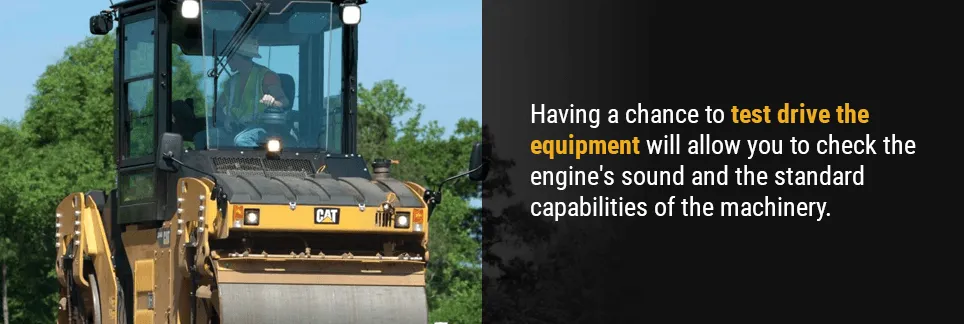
If you are familiar with the way the machinery should sound, drive and haul, then testing it will allow you to flush out any other problems you may have missed while checking the exterior of the machinery. Any engine problems that keep you from running it before purchase should not be passed over. No matter how attractive the deal seems, if the engine is not functioning the way you will need it to, refrain from buying the equipment.
Abnormal noises should make you question the shape of the equipment. Any unusual hiccups or coughs from the engine are suspect, and you should be wary of purchasing if the equipment is exhibiting these signs. If the seller is upfront about the machine’s defects and you still feel persuaded to buy, then you understand the risks involved with the purchase.
Perform basic maneuvers that you will need to do once the machinery is yours, so you know it is up for the job. If the equipment manages these actions, you can feel secure in your decision to purchase.
Watch for the kind of exhaust the used machinery may give off while you run it or test drive it. The combustion chamber could contain a defect or be reacting poorly due to lack of regular care. Steam and water emissions are an expected kind of exhaust, so do not panic if white vapor escapes the equipment sometimes. Cold starts with different colors of exhaust will show possible malfunctions in the machine’s system.
A different kind of white exhaust, separate from the steam and water type, often signals the presence of coolant. This can harm the engine, so pay attention to this type of exhaust. The way to tell the difference between coolant leakage and steam is that the white exhaust will persist even if the machine has been warmed up.
Black exhaust upon a cold start is typically due to too much gas is being burnt in the wrong way. This is only detrimental if this continues to happen, and it can also show that the combustion chamber needs more air or that a fuel component is not functioning. Blue smoke, which is much rarer, is the result of oil burning in the engine.
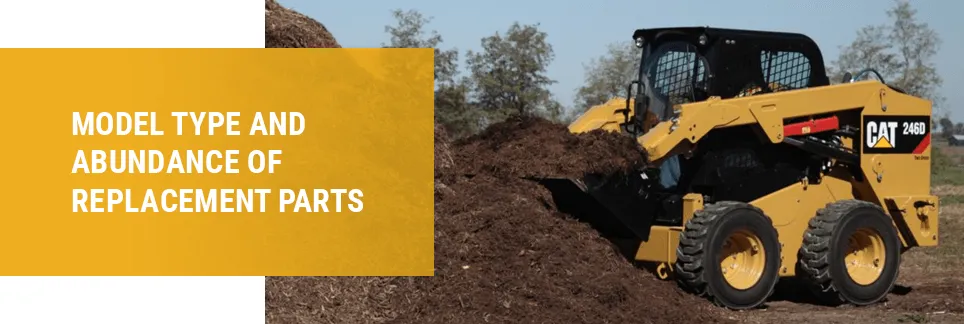
Used equipment can be older, so be careful to choose one that still has replacement parts available. Select a model of machinery whose manufacturer still carries the parts that you suspect will wear down most quickly. Whether you need a used cylinder, carburetor, steering valve or another piece, be sure that you can make repairs on your used machinery.
If a certain type of telehandler or articulated truck is more widely used than others, you will be able to find the parts that you need for maintenance and restorations. This leads to less downtime when a problem does arise because you can locate the piece quickly, have it delivered sooner and be up and running again shortly. To prevent hold-ups, find equipment and parts that will be readily available.
More resources are available for popular types of construction equipment, as well. If you are unsure how to proceed with repairs, advice from local dealerships or machinery experts will be easier to obtain. It is likely that others will have dealt with a similar complication and are ready to share the answer with you.
When preparing to make the transaction, ask the seller to provide documentation of the sale. For legal reasons, you will want to retain proof of purchase. To make sure you and the seller are both on the same page, confirm the purchase with a verifying document and pay with a check or alternate method that can be tracked. Once you have obtained a receipt and the machinery, the transaction is now acknowledged and kept by both parties.
You will also have the machinery’s title transferred to you if you are paying the full amount for the equipment up front. If you are paying the price over time, you will eventually receive the title and can expect that document once you’ve paid off any loan.
Double check the documentation that states the absence of liens against the equipment. This means you should line up the seller’s information on the invoice of initial purchase. Verifying your purchase from a seller or company will also assist you if you decide to sell your used equipment at a future time and need documents to show other buyers.
In construction, you are looking for the most cost-effective and efficient machinery to complete your projects. Gregory Poole Equipment Company provides this kind of machinery with professional service and quality manufacturing brands along with available financing. Whether you are looking for used Cat machinery or used parts, we are prepared to meet your needs with reliable and technical expertise.
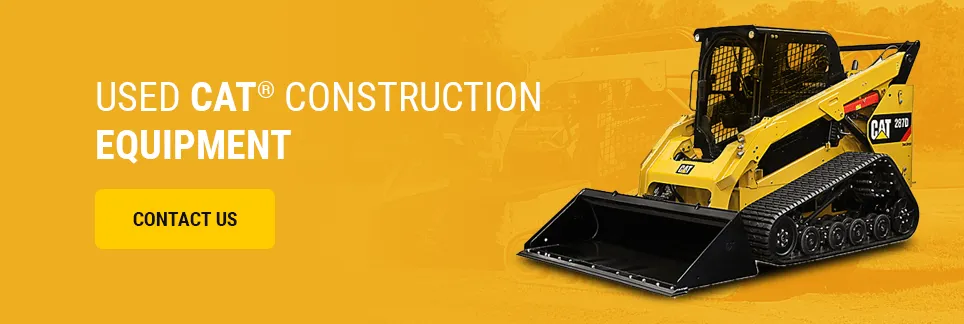
With over 65 years of experience and 13 locations across eastern North Carolina, Gregory Poole is a part of a strong dealer network and can distribute the parts you need, often within 24 hours. We also support our customers after sales with valuable product support. Gregory Poole offers the used Cat construction equipment that will get your construction projects finished.
Contact us today with any questions about our used Cat construction equipment or check out our available used machinery now.